Lower elementary students are having their turn with the parachute this week! And, needless to say, they are LOVING the parachute. We start with introductory concepts (where to stand, how to hold the parachute safely, etc.), then practice how to inflate the parachute without it. Then, it's time for the fun! We shake the parachute - slow/fast, high/low. We inflate it - making a big bubble up above our heads. Depending on the grade level, we do different things - we might inflate it several more times, do color switching activities (under/around the parachute), shake the parachute with foam balls on top (popcorn), and go under the parachute after inflating (igloo).
Although the parachute is clearly AMAZINGLY AWESOME, we are working on many important concepts while we are having fun. Movement concepts for lower elementary students during parachute include:
- sudden/sustained movements
- moving in unison = all together at the same time
- strong/light movements (use a large amount of force or a small amount)
- high/low, start/stop, slow/fast, big/small
- up/down, on/off, above/below
Many of these concepts are relationship-based, so they are hard to measure -- but certainly very important in daily life and in other subjects!!
 |
| Kindergarten enjoying the parachute! |
 |
| Young Fives |
Upper elementary students are working with paddles. For their first lesson this week, they use their hands as paddles. They start with a ball at individual wall spaces. Tasks include:
- hit the ball with one hand and catching it, then hit with the other hand
- try to continuously hit the ball against the wall at your wall space - see how many you can do without losing control of the ball
- try to hit the ball against the wall with one hand, then the other hand - alternating this way - see how many you can do without losing control
- try to hit the ball and hit the target
Then, we gather near the dry erase board and go over rules for two square:
- play starts with a bounce-serve
- ball must go over the center line
- one bounce only allowed
- after you hit it, the ball must bounce inside your opponent's square
- keep score:
- one point scored if:
- ball bounces twice
- ball lands out of bounds
Then we divide into pairs and play begins! Time permitting, groups combine into groups of four and begin playing four square. One fifth grade class asked to play four square indoors with playground balls, so for the last five minutes of class, we tried it.
 |
| Fifth graders play two square with hand paddles |
 |
| Fifth graders: four square |
 |
| Four square with a playground ball |
 |
| Fourth graders playing two square |
For their second lesson, they use an actual paddle to strike the ball. We have two types of paddles: wood and plastic. They are short, about 15" from the end of the handle to the tip of the paddle. We use them in a variety of ways to improve eye-hand coordination, and also for striking skills. Students are encouraged to try some or all of the following tasks:
- balance the ball on top of the paddle - knuckles up (forehand), fingers up (backhand)
- bounce the ball lightly up from the paddle (forehand and backhand trip)
- bounce the ball to the floor from the paddle
In ASD PE classes, we have added two stretches to our routine. The stretches happen after our warm up, which includes laps around the gym. We do laps that include walking, running, galloping, skipping, and sideways slide-stepping. Adding stretching to our routine helps with flexibility, and also helps prepare students for middle school PE, where stretching is often a part of every class.
SXI continues to enjoy playing t-ball, and working on activities and skills based on each individual student. These activities and skills may include tracking an object with eyes, holding/pushing/pulling a ball or object, throwing an object, throwing at a target, or catching.
1st grade PE/Humanities - Health: Medicines, Poisons & Tobacco
In health classes this week, first graders learned about staying safe from medicines and poisons. We learned some rules:
Medicine:
- only take medicine from a trusted adult
- never share medicine with another child
- never take more than a trusted adult says to take or gives you
Poisons:
If you're not sure what something is, never sniff, swallow, taste, or play with it!
We also learned about how smoking and tobacco use can damage our bodies, making our hearts work harder, and hurting our lungs and mouths. Students learned what secondhand smoke is, and ways that they, as first graders can avoid secondhand smoke. Ideas included:
- move away from the person smoking
- go to another room
- go outside
- open a window
- keep bedroom door shut if someone in the house smokes
- respectfully ask the person to stop smoking
Family resource sheets were also sent home for these topics, as well as our Personal Safety unit. We'll be learning about how to stay personally safe next week!













